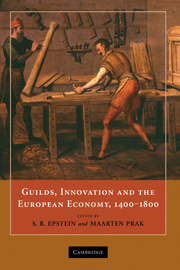Book contents
- Frontmatter
- Contents
- List of Contributors
- Acknowledgments
- Introduction: Guilds, Innovation, and the European Economy, 1400–1800
- 1 Craft Guilds, the Theory of the Firm, and Early Modern Proto-industry
- 2 Craft Guilds, Apprenticeship, and Technological Change in Pre-industrial Europe
- 3 Subcontracting in Guild-based Export Trades, Thirteenth–Eighteenth Centuries
- 4 Circulation of Skilled Labour in Late Medieval and Early Modern Central Europe
- 5 Painters, Guilds, and the Art Market during the Dutch Golden Age
- 6 Craft Guilds and Technological Change: The Engine Loom in the European Silk Ribbon Industry in the Seventeenth and Eighteenth Centuries
- 7 Guilds, Technology, and Economic Change in Early Modern Venice
- 8 Inventing in a World of Guilds: Silk Fabrics in Eighteenth-century Lyon
- 9 ‘Not to Hurt of Trade’: Guilds and Innovation in Horology and Precision Instrument Making
- 10 Reaching beyond the City Wall: London Guilds and National Regulation, 1500–1700
- 11 Guilds in Decline? London Livery Companies and the Rise of a Liberal Economy, 1600–1800
- Index
9 - ‘Not to Hurt of Trade’: Guilds and Innovation in Horology and Precision Instrument Making
Published online by Cambridge University Press: 24 June 2009
- Frontmatter
- Contents
- List of Contributors
- Acknowledgments
- Introduction: Guilds, Innovation, and the European Economy, 1400–1800
- 1 Craft Guilds, the Theory of the Firm, and Early Modern Proto-industry
- 2 Craft Guilds, Apprenticeship, and Technological Change in Pre-industrial Europe
- 3 Subcontracting in Guild-based Export Trades, Thirteenth–Eighteenth Centuries
- 4 Circulation of Skilled Labour in Late Medieval and Early Modern Central Europe
- 5 Painters, Guilds, and the Art Market during the Dutch Golden Age
- 6 Craft Guilds and Technological Change: The Engine Loom in the European Silk Ribbon Industry in the Seventeenth and Eighteenth Centuries
- 7 Guilds, Technology, and Economic Change in Early Modern Venice
- 8 Inventing in a World of Guilds: Silk Fabrics in Eighteenth-century Lyon
- 9 ‘Not to Hurt of Trade’: Guilds and Innovation in Horology and Precision Instrument Making
- 10 Reaching beyond the City Wall: London Guilds and National Regulation, 1500–1700
- 11 Guilds in Decline? London Livery Companies and the Rise of a Liberal Economy, 1600–1800
- Index
Summary
Clock and watch making in the mid-fifteenth century can be considered a new trade in Europe. Although instrument making can hardly be considered a trade at all, the two occupations were intertwined – despite which the multi-faced, hard-to-define, small-scale nature of instrument making would mean that, unlike clock making, it would never become incorporated as a recognised trade. The two had developed together from the mid-thirteenth century onwards, when a new semi-autonomous mechanism, controlled by a falling weight for sounding bells, was combined with displays that presented visually not only the hour, but also the place of the Sun and Moon in the zodiac, the rising and setting of the signs, the length of day and night, the seasons, and, more rarely, the movements of the planets. The development of an alternative motive force – the controlled unwinding of a coiled spring – in the early to mid-fifteenth century made possible the introduction of a new range of portable and personal timekeepers, but many of them still offered calendrical and astronomical indications. At the same time, sundials were essential for setting any mechanical timepiece should it stop, and for checking the (often variable) time it showed against that given by the only available standard – the movement of the sun. The making of sundials therefore became associated with clock making.
- Type
- Chapter
- Information
- Guilds, Innovation and the European Economy, 1400–1800 , pp. 264 - 287Publisher: Cambridge University PressPrint publication year: 2008
- 1
- Cited by

